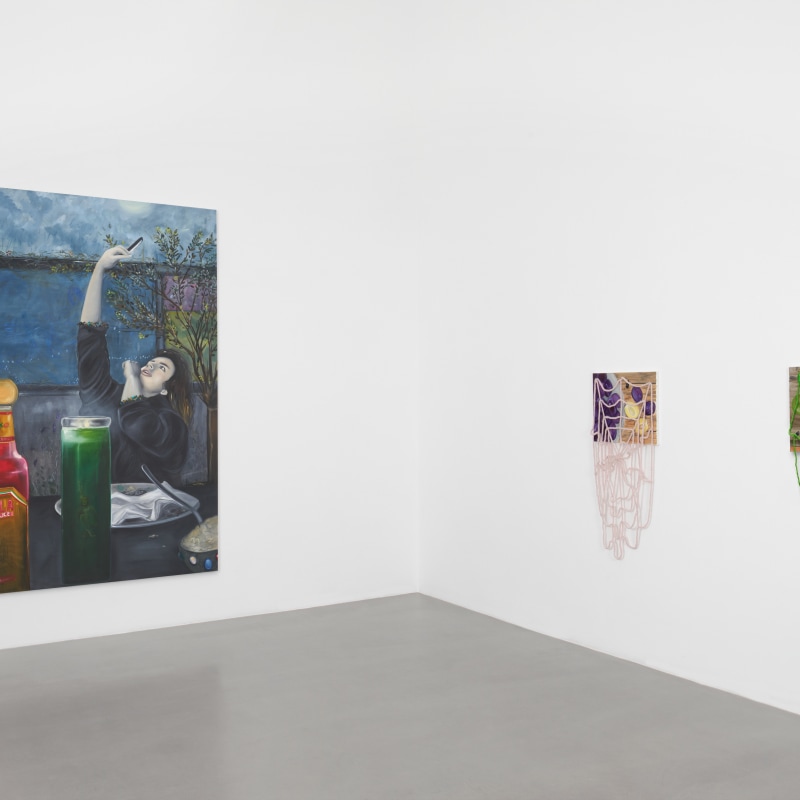Katja Seib’s second exhibition at Sadie Coles HQ comprises a group of new paintings and works on paper. These reveal a newly autobiographical focus, featuring depictions of her partner, their child, and other people from her life. And yet, throughout Seib’s latest works, ‘real life’ is poised to slide into a dreamlike register – refracted by symbolism and historical imagery.
Remington hot springs (2022) is a three-part painting in oil on linen, depicting figures bathing in a hot spring. One man sits with his limbs extended, his feet plunging into the foreground with elongated perspective. A second man crouches in the centre panel, half-submerged, and looks towards a figure who lies beyond the perimeter of the third canvas – visible only as a hand and foot at the very edge of the image.
The picture originated in a trip to the Sequoia National Park, close to the artist’s home in Los Angeles. But she has abstracted the scene away from the specific moment. “I feel like the painting could be continued and continued,” she has commented, suggesting that the image has the capacity to reach beyond itself, into other realities. In its subject matter, it invokes multiple historical depictions of bathers in sunlit enclaves. At the same time, surreal additions – frogs and snakes that frolic in the water – puncture the naturalistic surface, engendering the air of a dream.
Making photos of the moon (2022) shows a woman holding up a phone to take a photograph. She sits at a table that acts as a boundary between her and the viewer, on top of which a discarded plate sits alongside a bottle of hot sauce. Small details destabilise the impression of an everyday event: the space behind the girl is an amalgam of oblong shapes, filled with spectral images that resemble ancient reliefs or wall paintings – a seated woman in profile, a reclining women (both based on paintings by the Victorian painter William Etty – female nudes in dignified classical guises). These might equally be a ‘real’ backdrop or windows into an imaginary dimension. A flowering creeper twines around the borders of the images, suggesting their physical presence in the scene. The objects on the table express a similar interplay of realism and dreamlike interpolation: a green candle bears the image of a sylphlike figure, exhaling a chain of bubbles; it could equally be a stamped design or a fantastical apparition.
In Eye of the storm (2022), Seib repeats the formula of a figure at a table. A man in a hat and a chequered shirt looks out to meet the viewer’s (and the artist’s) gaze, screening his mouth with his hand. This time, the intermediary space of the table is breached by a disembodied arm that reaches into the foreground of the picture, towards the man, holding a sprig of flowers. The two hands are condensed expressions of emotion – advancing and reticent. They find a curious parallel in the eagle’s claw that hovers at the top edge of the painting. In the coloured oblongs of the background, spatial depth is indeterminate: cloudlike wisps spread across panels of thickly-layered blue and green, while linear – liminal – images flicker inside the colour; one of these derives from a painting of 1792 by Elisabeth Vigée Le Brun, showing the artist’s daughter. ‘Real’ birds appear to fly, meanwhile, just in front: a sparrow, a crow, a dove and a parakeet.
Other works appear more straightforwardly documentary. In smaller paintings, Seib’s partner is shown feeding their baby with a bottle, or taking a shower. “I wanted to move away from the classic images in which women were painted with their children, or fathers with sons, and to point out the intimacy of a father with his daughter,” she has said. But in these works, too, a note of universalism – or longer history – persists. Everywhere in Seib’s latest works, figures and objects seem to hover on the cusp of symbolic import. The recurring motif of the apple carries echoes of Eve’s transgression. Small, scintillating details – a chain of flower’s around a girl’s arm, for example, or sprigs of lavender – echo the intricate symbolism of medieval and Renaissance art, while refuting finite interpretation.
Katja Seib (b. 1989, Düsseldorf, Germany) graduated with an MFA from the Fine Art Academy of Düsseldorf. Seib’s first solo exhibition dear diary was held in London at Sadie Coles HQ (2018), and she has since presented the solo exhibitions chasing rabbits at Château Shatto, Los Angeles (2019) and Happy Endings Don’t Bore Me at dépendance, Brussels (2020). She has also been featured in exhibitions including Luncheon on the Grass, Jeffrey Deitch, Los Angeles (2022); Private Passions, Karpidas Collection, Dallas (2021); Made in L.A. 2020: a version, Hammer Museum, The Huntington Library, Art Museum, and Botanical Gardens, Los Angeles (2020) and Salon des Amateurs, a presentation of works by the pupils of Peter Doig and Tomma Abts, at Tramps, London (2018). Seib lives and works in Los Angeles.
